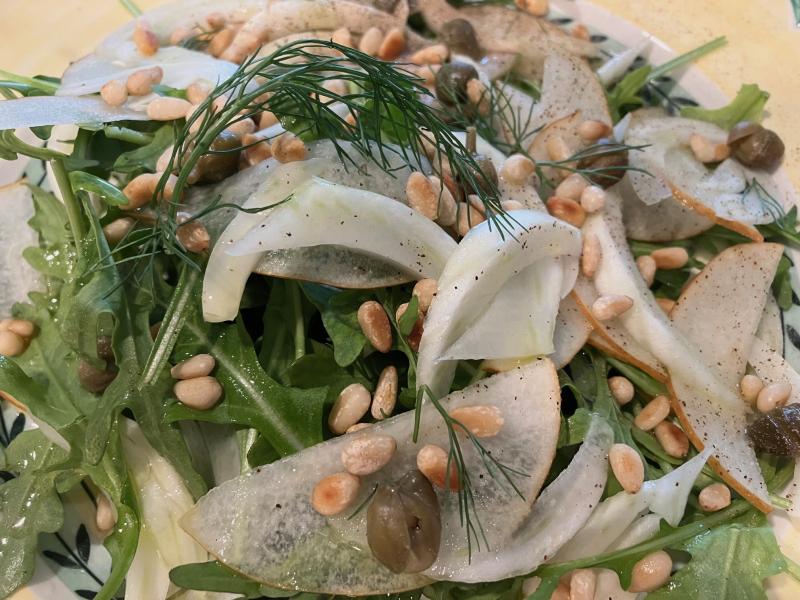Raw or cooked, fennel adds zest to many dishes
On a recent trip to the grocery, I found a lovely fennel bulb with delicate fronds still moist and intact – a sure sign this was quite fresh. Fennel (sometimes mislabeled as anise in the supermarket) is a cool-weather crop that’s at its best this time of year. The white bulbs have green stems topped with feathery green fronds that resemble dill weed.
Botanically, fennel is related to both carrots and parsley, with an unmistakable licorice-like flavor in the bulb as well as the seeds. Like so many foods that have been around for centuries, fennel has a history of both medicinal and culinary uses, from ancient China where it was considered a remedy for snake bite to the Middle Ages where it was hung over doorways to repel evil spirits.
Fennel was prized by the ancient Romans and Greeks, who documented instructions for using fennel as medicine, food and insect repellent. In Greek mythology, Prometheus was reputed to have carried fire from Mount Olympus to Earth in a giant stalk of fennel, taking advantage of its hollow center. Warriors drank fennel tea to improve their strength and stamina. Several herbal references cite fennel as an aphrodisiac.
The most popular variety of fennel cultivated commercially is Florence fennel or finocchio, prized for its fleshy bulb. Another type known as common fennel is the source of the seeds used in sausage and spice mixes. Both evolved from a wild ancestor native to the Mediterranean region. Seeds are sweet and aromatic, often found in Italian sausage and sauces, baked goods, sauerkraut and pickles. Eating fennel seeds is believed to aid digestion and relieve gassiness; some cultures chew the seeds after a heavy meal.
Most modern recipes that call for fresh fennel don’t make use of the stalks or leaves, including only the cored and trimmed bulb. The flavor of raw fennel has a subtle hint of licorice (not like black jelly beans, more like a memory of the scent). Thinly sliced fennel adds crunch and taste interest to a salad, especially when paired with pears, as in the photo.
When roasted, fennel wedges caramelize at the edges and lose their crunch, becoming tender and sweet. The licorice notes that were so discernible when the fennel was raw remain only a hint after roasting. But you needn’t put the stalks in the compost heap; add them to your soup pot when making a stock or dice them into your mirepoix to replace the celery. Use the stalks mixed with your favorite herbs to infuse this signature flavor to fish filets steamed in parchment paper. The fronds are a lovely garnish and can be snipped into salad greens or over steamed vegetables.
When shopping for fennel, look for fresh, unblemished bulbs that feel heavy for their size. The tips of the stalks shouldn’t be dried out, and the bottom of the bulb shouldn't show any browning. Store them wrapped in a plastic bag in your crisper drawer and try to use them within a few days – wilted fronds are a sign its almost past time to use the bulb. Whether you use the seeds, the bulbs or the fronds, consider inviting fennel to your table.
Fennel & Pear Salad
3 C baby arugula
1/3 C pine nuts
2 Bosc pears
1 fennel bulb
1 T capers
3 T olive oil
1 T lemon juice
1 T rice wine vinegar
salt & pepper, to taste
Place the arugula in a serving dish; set aside. In a dry skillet, toast the pine nuts until fragrant and golden; scatter over the arugula. Core the pears and thinly slice; scatter over the arugula. Trim the fennel bulb, reserving fronds for garnish. Cut in half and then into thin wedges, discarding the core; scatter over the arugula. Toss the capers over the arugula. Whisk together oil, lemon juice and vinegar; drizzle over the salad. Garnish the salad with fennel fronds. Season to taste with salt and pepper, keeping in mind the capers are little salt bombs. Yield: 4 servings.
Roasted Fennel & Carrots
2 fennel bulbs
3 carrots
1 T olive oil
1 T Balsamic vinegar
salt & white pepper
parsley, for garnish
Preheat oven to 375 F. Line a rimmed baking sheet with aluminum foil; set aside. Trim the fennel bulb, reserving trimmings for another use. Cut in half and then into wedges; set aside. Peel the carrots; cut in half lengthwise and then into 2-inch pieces. Place the carrots and fennel in a bowl and drizzle with oil and vinegar; toss to coat. Arrange the vegetables in a single layer on the prepared pan. Sprinkle with salt and white pepper. Roast until soft, about 35 to 40 minutes. Garnish with parsley. Yield: 4 servings.
Fennel Pork Tenderloin*
3 lb pork loin
2 T fennel seeds
3 cloves garlic
2 t red pepper flakes
2 T kosher salt
2 thick slices of orange rind
2 T dry vermouth
Combine seeds, garlic, red pepper, salt and orange rind in the bowl of a food processor. Pulse until you have a thick paste. Stir in vermouth and rub all over pork loin. Seal in a plastic bag and refrigerate overnight. When ready to cook, roast in an oven preheated to 350 F. Cook until meat thermometer registers 145. Allow to rest for 10-15 minutes before slicing. *Adapted from Food52.




















































